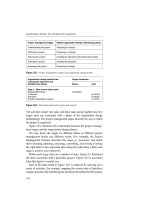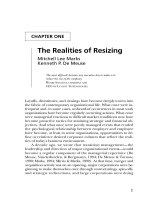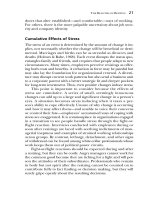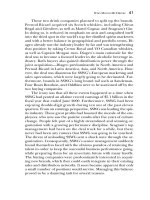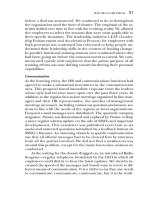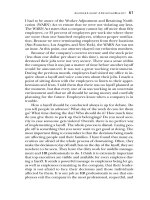Resizing The Organization 7 pot
Bạn đang xem bản rút gọn của tài liệu. Xem và tải ngay bản đầy đủ của tài liệu tại đây (88.15 KB, 10 trang )
Those two drink companies planned to split up the brands.
Pernod Ricard acquired six Scotch whiskies, including Chivas
Regal and Glenlivet, as well as Martel Cognac and Seagram’s Gin.
In doing so, it reduced its emphasis on anis and catapulted itself
into the third spot in the world’s top five distilled spirits marketers
and with a better balance in geographical and portfolio terms. Di-
ageo already was the industry leader by far and was strengthening
that position by taking Crown Royal and VO Canadian whiskies,
as well as Captain Morgan rum. Diageo’s main rationale for the
deal was to become a focused leader in the alcoholic beverage in-
dustry. Both buyers also gained distribution power through the
joint acquisition—Diageo predominantly in North America and
Pernod Ricard in Latin America, Asia, and North America. How-
ever, the deal was disastrous for SSWG’s European marketing and
sales operations, which were largely going to be decimated. Fur-
thermore, brands in SSWG’s long brand tail such as Sandeman,
Four Roses Bourbon, and Oddbins were to be auctioned off by the
two buying companies.
The irony was that all these events happened at a time when
SSWG had posted an all-time record earnings of $5.1 billion in the
fiscal year that ended June 2000. Furthermore, SSWG had been
enjoying double-digit growth during ten out of the past eleven
quarters. From an earnings perspective, SSWG was leading the spir-
its industry. These great profits had boosted the morale of the em-
ployees, who now saw the positive results after five years of culture
change. People felt part of a highly streamlined and winning or-
ganization with a growing performance discipline. Seagram’s top
management had been on the deal track for a while, but there
never had been any rumors that SSWG was going to be touched.
The threat of unloading SSWG sent a shock wave through the or-
ganization. Consequently, SSWG’s senior management suddenly
found themselves faced with the obvious paradox of retaining the
talent in order to keep the successful business performance going,
while preparing them for an uncertain future with many layoffs.
The buying companies were predominantly interested in acquir-
ing new brands, which they could easily integrate in their existing
sales and distribution networks. It soon became apparent that only
a small number of positions would survive. Managing this balance
proved to be a daunting task for several reasons.
WHO MOVED MY DRINK? 41
TEAMFLY
Team-Fly
®
42 RESIZING THE ORGANIZATION
A Very Long Period of Uncertainty:
The Breakup Syndrome
SSWG employees had lived through many reorganizations during
the past ten years due to a massive reengineering effort that Bronf-
man had started in the “old Seagram” in 1994. From this time,
Bronfman had acquired entertainment assets, signaling that the
transformation of Seagram was going to be more fundamental
than simply reorganizing inspired by a drive for enhanced perfor-
mance and effectiveness. A particular psychological aspect played
an important role in this transformation. A critical difference be-
tween Seagram and Vivendi was that Vivendi was management
dominated, whereas Seagram was largely a family company. The
wealthy and powerful Bronfman family held about 28 percent of
the shares of Seagram. The family business mentality had been par-
ticularly prevalent in the spirits business, the origin of Seagram.
Typical traits of SSWG’s culture had been its inward-oriented focus,
formal and top-down communication, multiple layers, arrogance,
and a disciplined, dedicated, and committed workforce with high
loyalty to the Bronfman family. For a long time, many SSWG em-
ployees had felt that they were the masters of the universe in the
Seagram empire. However, by 1998, they started to feel increasingly
reduced to a position of a money maker, subsidizing the newly ac-
quired entertainment assets (some of which were loss making).
Nevertheless, the workforce remained loyal to the Bronfmans for
the next few years, because most employees were convinced that
they would never sell the spirits and wine business. The Vivendi
Universal deal was a major blow to many of the SSWG employees,
who felt deeply let down by the Bronfmans, especially in North
America, which accounted for 60 percent of the total business and
where the strongest growth was being realized.
Following the announcement of the Vivendi Universal creation
in June and the SSWG sale by the end of 2000, there arose a hos-
tility and resentment toward the new owners of the company, par-
ticularly from the many long-serving employees. Many of the SSWG
employees from the senior ranks downward were resentful and
angry at what they perceived to be the selling out of the company
on the part of Bronfmans. Any communication by the family about
the business reasons for the sale was felt to be lacking in empathy
and sensitivity. Edgar Bronfman became a target of derision and
frustration. There was undoubtedly a lot of projection going on of
people’s feelings and frustration. Any communication from him
about the business reason for the sale was perceived to be lacking
in empathy and insensitive to employees. Pointed sarcastic remarks
bounced back and forth on Seagram-related chat boards. The idea
that something great was coming to an end was very difficult. The
task was to channel everyone’s strong negative emotions and anx-
iety into something positive. In most people’s minds, somebody
had definitely moved their drink, for good.
This anger was fueled in late September 2000 when the Inter-
national Herald Tribune rumored that Bronfman reportedly had op-
posed the planned buyout of the spirits business by a consortium
led by SSWG’s management team. The auction of SSWG from Sep-
tember until late December 2000 turned out to be a chaotic and
messy affair, highly entertaining for outsiders but not for the SSWG
employees. The players in this particular drama were six of the
world’s largest drinks producers, who found themselves caught up
in a six-month bidding war. At stake was the largest portfolio of
drink brands ever to be put on sale, giving each of those compa-
nies a unique chance to secure leading positions in key categories
around the globe, particularly in North America. To the other
large group of stakeholders, the SSWG people, it seemed that
Vivendi Universal, the investment bankers, and the dealmakers
were giving very little consideration to their needs.
SSWG’s management team continued to stay together. All of
them supported each other in overcoming the disappointment of
not being able to carry out their management buy-out. This enabled
them to present a united front, sending the message that “we all are
in this together” to the organization. They communicated to the or-
ganization openly and with credibility about why they had aban-
doned their buy-out effort and that they now would support the next
best solution. The various regional presidents followed up their gen-
eral communication by discussing the recent happenings face-to-face
with their employees. At the same time, the human resource func-
tion took a lead role in preparing the organization for transition and
made moves to mitigate the sense of impending personal loss.
WHO MOVED MY DRINK? 43
44 RESIZING THE ORGANIZATION
A Prolonged Pain
One other factor made the emotional roller coaster even more
stressful: the date of the close of the deal kept moving. When the
deal was announced in December 2000, all parties involved were
convinced that they would get regulatory approval in the United
States, Canada, and Europe by the end of March 2001. In the hot
merger and acquisitions summer of 2001, General Electric saw its
deal with Honeywell blocked by the European Union Commission
in Brussels. United Airlines received thumbs down in its takeover
bid for United Air in the United States. Diageo and Pernod Ricard,
in turn, had clearly underestimated the difficulty and the complex-
ity of the transaction and the scrutiny of the Federal Trade Com-
mission in the United States. A transaction directly involving two
major competitors head-on and a breakup of a large company is
bound to be more complex than some of the other megamergers.
Add to this mix the complicated split-up of brands and countries.
The use of firewalls (a set of procedures to protect competitor-
sensitive data following the closure) was imposed from the start.
Nevertheless, all the complexity from a systems and people per-
spective that comes with such procedures was known in advance.
Although the European Union gave its approval in May, the clos-
ing date initially slipped to the end of June, then to the first of July,
followed by announcements that it was slipping further to the end
of July and then August. As I am writing this chapter, it now is ten-
tatively scheduled for the end of October (with possible further de-
lays). Never underestimate the time it takes to clear a deal and the
emotional toll it takes on people when they hear conflicting mes-
sages all the time, especially when they anticipate that they will not
have a job at the end of it.
Preparing the Organization
for Transition and Closure
During the fourteen months since the announcement of the in-
tention to sell SSWG, managing and working in SSWG became ex-
tremely difficult. We took many initiatives with long- and short-term
effects to help the organization and the people get through this
transition.
Preparation for the Long Term: An Ongoing
Senior Management’s Agenda Item
In this day and age of numerous mergers and acquisitions, it always
is good management practice to be prepared for them at any time.
In the case of SSWG, the positive impact of eight years of contin-
ued performance-enhancing actions only now became apparent
to its full extent. It had started with five years of intensive reengi-
neering of over forty business processes and deep culture change
based on formulating, cascading, and training in the Seagram Val-
ues: a customer and consumer focus, quality, innovation, team-
work, respect, and integrity. In addition, the subsequent overhaul
of the employee development and management processes proved
to be a solid foundation to deal with the breakdown in a more ma-
ture way than otherwise would be possible. All of those efforts had
culminated in the creation of a vision for “One Team Seagram”
and a strong centralized functional matrix organization in 1998.
This effort had put the organization back on track, had increased
its executional excellence, and had instilled a strong discipline in
approaching its business in the organization.
From mid-1994 until late 1997, more than forty cross-functional
teams had examined and redesigned every process in the areas of
finance, consumer marketing, customer development, order ful-
fillment, manufacturing, purchasing, information technology, and
business planning. These efforts resulted in a more process-oriented
company, significant cost reductions, a number of layoffs, a more
effective organization, and enhanced business performance. How-
ever, process redesign was not sufficient to obtain those results. It
went hand in hand with a companywide culture change process ini-
tiated by the chief executive officer (CEO) and carried out over a
five-year period. During this time, the Seagram Values were formu-
lated, cascaded, and integrated into the way we were doing busi-
ness and managing our people. This entailed rolling out business-
focused values sessions to all employees over a two-year time frame,
as well as combined the installation of a 360-degree feedback
process for senior and middle managers and a significant change
in top leadership positions.
Edgar Bronfman, Jr., had been instrumental in starting the reen-
gineering and values initiatives and oversaw them over a four-year
WHO MOVED MY DRINK? 45
46 RESIZING THE ORGANIZATION
period. The good news for SSWG was that its chief executive, Steve
Kallagher, had been the reengineering leader at the onset and con-
sistently and ardently sustained both initiatives in the company. Un-
doubtedly, those efforts created the nurturing ground for the
fundamental change of SSWG that proved to be the ideal founda-
tion to build it into a high-performing company. And though not
intended as such, these interventions also created the enabling
conditions to see the organization and its people through its ulti-
mate breakup (while being able to maintain focus and business
momentum). The basic discipline of creating a quality process
staffed by talented people and running it with a deep respect and
integrity was certainly rooted in the initiatives of the mid-1990s.
I consider all those change initiatives necessary to be part of
any top management agenda on an ongoing basis. It highlights
that the best time to prepare for a combination with one or more
companies starts a long time before it actually happens so that ad-
equate conditions are created long in advance that will enable a
more humane transition.
Medium-Term Preparation: Anticipating the Deal
From the time of the announcement of the intended sale of the
company and during the time of the auction, we in the human re-
source (HR) function embarked immediately on preparing to help
the organization through the transition. The senior HR team met
and discussed the large number of issues involved in a combina-
tion of companies with respect to the organization overall and the
individuals. We opted to be proactive rather than wait until it was
clear who were the buyers. We agreed on a course of action, start-
ing with the preparation of the HR function. We all knew that fun-
damentally mergers and acquisitions are a very negative experience
for employees, their families, and the communities in which they
live. Therefore, in line with the Seagram Values, we were going to
try to help our employees through this process with respect and
integrity, regardless of who was going to be the new owner of our
company. We also realized that our HR professionals had to learn
more about combinations and the nature of HR advice and the
work it entailed.
A Credible HR Function Takes the Lead
There also was a business reason for the swift HR reaction: we were
determined to help senior and line managers maintain focus on
the business and stay on track to attain the ambitious business tar-
gets that were established. By doing this, SSWG employees would
be able to keep themselves busy and gain a sense of achievement,
thus somewhat offsetting the feeling of personal loss. We contin-
ued to demonstrate that we were attending to the personal and
emotional dimension of our employees, while at the same time fo-
cusing on achieving the business objectives.
One major condition allowed us to take a lead position. The
HR function in SSWG had become one of the strongest functions
during the past three years as a consequence of two events: the re-
design of the way in which HR management was being handled
and the extensive upgrade of the caliber of the HR professionals
we employed. A senior team of line managers and HR specialists
had reengineered the human development and management
processes and accountabilities. The new approach was branded
“Team Seagram—You’re the business” and provided employees
with a framework for development based on ongoing dialogue
about goals and performance. It applied five integrated people
processes to fundamental business goals. More important, line man-
agement owned it. Performance management and talent detection
and development were the cornerstones of Team Seagram. The HR
function acted as facilitator of the processes and was the custodian
of the “People Plan,” which addressed the critical people and or-
ganization issues at the heart of strategic planning. By mid-2000,
the HR function was enjoying an excellent reputation as an influ-
ential strategic business partner. SSWG’s CEO publicly attributed
the outstanding business results of fiscal year 2000 to an important
extent to Team Seagram and the efforts of the HR function.
A Catalytic HR Learning Event
In the context of the dramatic changes facing SSWG, the HR func-
tion quickly became the best-prepared function and a model for the
other functions. The senior HR team decided to design and organize
a large-scale three-day learning event for the entire function around
the world before any buyer was announced. The communications
WHO MOVED MY DRINK? 47
48 RESIZING THE ORGANIZATION
and legal functions were included because we would be working
closely with each other. The event had the following aims:
1. Strengthen the global HR network.
2. Prepare the organization, the HR function, and its individuals
for the imminent task at hand.
3. Develop, with the help of some board members and invest-
ment bankers, the capability of the function by learning about
the business context of the imminent acquisition and the busi-
ness backgrounds of all possible future partners.
4. Learn from authoritative consultants and other companies that
had gone through similar experiences about the dynamics of
combining companies and why they often fail.
5. Put a global action plan together for the upcoming six months.
The learning experience was highly interactive and participa-
tive. We started by listening to individual concerns, hopes, and
fears, as well as allowing them to surface collectively. A key design
principle of the conference was to influence the reigning mind-set
characterized by a victim syndrome and to help the participants
see a different way of approaching an acquisition. We stressed that
although one may not be in charge, one can still build an inclusive
scenario and offer to co-create a win-win proposition for the new
venture in partnership with the buyer. We accomplished this goal
through many sessions in which all participants were involved in
building future successful scenarios in which they would like to
contribute their capabilities. We derived a set of HR principles for
dealing with separation, selection, and integration, carefully de-
scribing what success would look like. Everything was written in an
HR blueprint document for integration, which was shared among
the entire HR function. Subsequently, it was passed on to the HR
professionals of the buying companies.
We started the conference with a basic discipline of extensive
question-and-answer sessions for ourselves that later became the
model for communication sessions with line managers. Such ses-
sions were repeated regularly across the globe during the follow-
ing months whenever management or employee meetings were
taking place. At the end of the conference, the HR function had
not only enhanced its capability but had unified its understanding
of what the function stood for and how we would influence the
buyer to co-create the future if it opted to do so. All participants
agreed to take the following collective actions:
1. Gear up communications at the local levels as a partnership
among the line manager, HR, and communications functions.
2. Provide local teams with an overview of why mergers frequently
fail and how to turn them into successful combinations.
3. Answer as many of employee questions as possible in local
meetings and road shows.
4. Build or update local, regional, and global human resources
databases.
5. Encourage employees to prepare for the impending transition
by offering sessions on managing change to increase their un-
derstanding of the marketplace and competitors, resumé writ-
ing skills, and interviewing skills seminars.
6. Provide regular local and regional communication briefings
through the regional HR vice presidents.
7. Identify their HR counterparts at the potential buyers and ini-
tiate a telephone call the day after the preferred bidder was an-
nounced. (Seventy telephone calls were placed worldwide one
day after the announcement of the deal.)
Nine months later, this three-day conference has proven to be
a major catalyst for the entire transition process. It built strong con-
fidence and created cohesion in the HR function, which played a
lead role in the dialogue with the buyers. We influenced their
thinking substantially about HR resourcing principles and helped
them to fine-tune their processes for making choices about people
and talent integration, staff redundancy, and severance issues. We
often found ourselves in a key referee and influencer role during
the transition planning, especially in the detailed brand-by-brand
and market-by-market approach. The consistent and persistent way
in which this was handled within SSWG was a major achievement
of the HR learning event.
Short-Term Preparation: When the Heat
Is On, All Focus on the People
The feedback from these activities indicated that the long-lasting
uncertainty started to cause a significant emotional drain on the
WHO MOVED MY DRINK? 49
50 RESIZING THE ORGANIZATION
staff. Immediately after the HR event, a long series of focused in-
terventions for the individual employees were designed by the or-
ganization development team and started to be implemented in
December 2000. Most of those events were one-day or half-day
sessions with either a practical or a psychological-emotional focus.
Included in the former were workshops on resumé writing, inter-
viewing skills, networking, negotiating new work agreements, and
career workshops. The last session gave participants an insight into
their deeply held career interests and anchors, preferences, and
capabilities and how to put these together in a balanced and real-
istic career perspective.
To provide support at a psychological-emotional level, we of-
fered employees the following:
• Taking-stock sessions in which participants were coached to
bring out their areas of strength they can carry forward to a
new role, using our 360-degree feedback instrument or other
psychometrics.
• Personal coaching for senior executives.
• “Me and Transition” workshops to equip employees with the
knowledge, mind-set, and tools to cope with the stress of a
transition process and to help them understand their emo-
tions experienced as a result of loss or negative change. Em-
phasis was placed on developing positive tactics and tools to
manage transition and identifying actions for feeling more
confident, regaining a sense of control, and remaining pro-
ductive on the job.
• “Thriving on Change” sessions. Because the most people with
the longest service worked in the United States, management
in that region expressed a specific need for assisting employ-
ees through their career transition with guidance and support.
The objective of those work sessions was to work with their em-
ployees in identifying and developing the necessary skills and
techniques to navigate through the change effectively. We at-
tempted to find new opportunities consistent with their capa-
bilities, interests, and career objectives. It included completing
self-assessment exercises and individual coaching follow-up.
Many companies in a merger and acquisition situation tend to
offer similar sessions. We went a step further by offering them even


